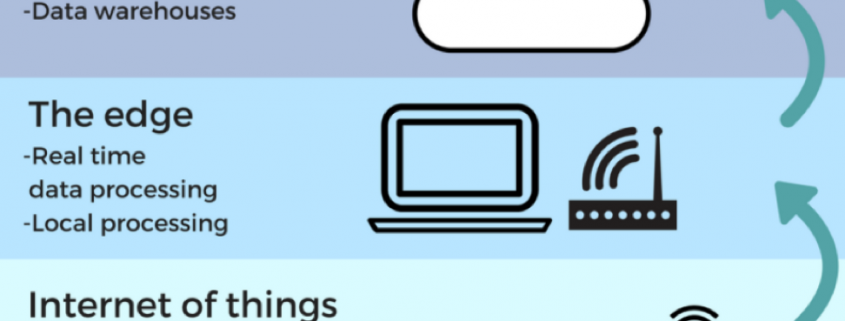“Will the social networking phenomenon lessen? I don't think so.” - Said Former CEO of Yahoo Marissa Mayer
When John identifies a strategic exit point, he will send you an alert with specific trade information as to what security to sell, when to sell it, and at what price. Most often, it will be to TAKE PROFITS, but, on rare occasions, it will be to exercise a STOP LOSS at a predetermined price to adhere to strict risk management discipline. Read more
Mad Hedge Technology Letter
October 9, 2018
Fiat Lux
Featured Trade:
(LIVING ON THE EDGE),
(AMZN), (MSFT), (HPE), (GOOGL)
What is Edge Computing?
Edge computing is processing data at the edge of your network.
The data being generated will not only occur in a centralized data-processing storage server anymore, but at different decentralized locations closer to the point of data generation.
This is what everyone is talking about and is an epochal development for tech companies and the businesses they run.
The last generation of IT saw a massive migration to the cloud as centralized servers stored the sudden hoard of data that never existed before.
Edge computing bolsters data performance, boosts reliability, and cuts the costs of operating apps by curtailing the distance data must flow which effectively reduces latency and bandwidth headaches.
Edge computing is revolutionizing IT infrastructure as we know it.
No longer will we be forced to use these monolith-like giant server farms for all our data needs.
Epitomizing the Silicon Valley culture of becoming faster and more agile to disrupt, tech infrastructure is getting the same potent cocktail of performance enhancers underlying the same characteristics.
According to research firm Gartner, around 80% of enterprises will shutter legacy data servers by 2025, compared to 10% in 2018.
Keeping the data near the points of data creation is the logical step to enhance and optimize data processes.
Cloud computing depends on superior bandwidth to handle the data load.
This can create a severe bottleneck if bombarded with a heavy dose of devises all communicating with the centralized servers.
The edge computing industry already in the initial stages of ramping up will be worth $6.72 billion by 2022, up from $1.47 billion in 2017.
Underpinning this crucial IT is the imminent inauguration of 5G networks powering IoT devices.
Simply put, the amount of raw data which will need swift processing is about to explode. Relying on a slower, centralized servers is not the solution, and the edge offers a suitable solution to accommodate the new generation of technology.
And as technology starts to permeate every corner of the globe, data will need to be instantaneously processed locally in cutting-edge technology such as self-driving cars.
Waiting on communicating with a centralized server in another continent is just not plausible.
A self-driving car only has milliseconds to react in hazardous conditions.
Other critical and data heavy operations such as wind turbines, medical robots, airplanes, oil rigs, mining vehicles, and logistics infrastructure only function if operated at peak levels and an interruption to connectivity could be fatal.
Telecom companies and IT firms will experience the biggest sea of changes from edge computing in the next five years.
These two sectors are confronting a significant ramp up in network load and will find it challenging to deliver the results to operate the apps and services they are responsible to run.
This new IT technology is the answer.
The industry adopting edge computing the fastest is retail because of the troves of data collected by IoT sensors and cameras.
Companies will be able to analyze the performance of products and edge computing is the technology that will capture the data.
The adoption of edge computing will perfectly take advantage of the boom in IoT devices and uptick of internet speeds through 5G.
Sales of PC’s, tablets, and smartphones have matured, and aren’t seeing the same pop in growth rates like before.
However, the IoT industry will expand by 30% in the next five years boding well for the broad-based integration of edge computing.
In total, the number of connected devices in the next five years will balloon from 17.5 billion in 2017 to over 31 billion in 2023.
The first iteration of 5G IoT devices will be on the market in 2020 deploying industrial process monitoring and control.
This is not a flash in the plan technology and many firms already or are about to roll-out an edge computing strategy.
In a recent report, 72.7% of tech firms already possess a solid edge computing plan or it is in the works.
If you include all the tech firms who expect to invest in edge computing in the next year, the number catapults to 93.3%.
The same survey continued to delve into the mindset of edge computing for tech management by asking about the importance of the technology.
Over 70% of firms characterized edge computing as important, bifurcated into two categories with the first being “critically important” which 22.2% of respondent agreed with.
Another 49.6% of respondent described edge computing as “very important.”
Firms cited that improved application performance is the largest benefit of edge computing followed by real time data analytics and data streaming.
It is not the death of cloud computing yet.
Even though centralized, slower, and negatively affected by long distance, cloud computing still has a place in the future of IT.
About two-thirds of tech firms plan to utilize a hybrid centralized cloud – edge computing strategy.
Even if they did not combine this strategy, companies would most likely separate the operations responsible for two distinct set of tasks filtered by the level of time sensitivity.
The overwhelming and imminent adoption of IoT devices means IT departments are crafting a substantially higher budget for edge computing to satisfy their operational needs.
Large recipients of this technology will turn out to be companies related to manufacturing, smart cities and transportation as well as energy and healthcare.
This technology really cuts across the entire spectrum of global industries.
Data usually does not discriminate, and applications of new tech is fueling a rapid rise of performance optimization that no other sectors can claim.
Let’s do a quick rundown of the edge computing players.
The three cloud behemoths of Amazon Web Services (AWS), Microsoft (MSFT) Azure, and Google (GOOGL) Cloud are constructing edge gateways and edge analytics into their IoT offerings aiding workload distribution across edge and cloud services.
Microsoft has over 300 edge computing patents and launched its Azure IoT Edge service integrating container modules, an edge runtime, and a cloud-based management interface.
Amazon Web Services offers AWS CloudFront content delivery infrastructure and AWS Greengrass IoT service building on the momentum of pioneering centralized cloud technology.
Dell’s IoT division invested $1 billion in R&D to help drive Edge Gateways and VMware's Pulse IoT Center.
Hewlett Packard Enterprise (HPE) devoted $4 billion to its edge network portfolio. HPE operates edge services, mini-data centers, and smart routers.
These are just some of the initiatives from some of the main players in the field.
Expect companies to become a lot more connected while possessing the speed, high performance, and agility to optimally entertain this new-found connectivity.
“You have to be willing to be misunderstood if you’re going to innovate.” – Said Founder and CEO of Amazon Jeff Bezos
Mad Hedge Technology Letter
October 8, 2018
Fiat Lux
Featured Trade:
(A LONG-AWAITED BREATHER IN TECHNOLOGY),
(AMZN), (TGT), (NVDA), (SQ), (AMD), (TLT)
Taking profits - it was finally time.
The Nasdaq has been hit in the mouth the last few days and rightly so.
It was the best quarter in equities for five years, and a quarter that saw tech comprise up to a quarter of the S&P demonstrating searing strength.
It would be an understatement to say that tech did its part to drive stocks higher.
Tech shares have pretty much gone up in a straight line this year aside from the February meltdown.
Even that blip only caused Amazon (AMZN) to slide around 10%.
After all the terrible macro news thrown on the market in spades – tech stocks held their own.
Not even a global trade war with the second biggest economy in the world which is critical to exporting products to America was able to knock tech shares off their perch.
At some point, 26% earnings growth cannot sustain itself, and even though the tech narrative is still intact, investors need to breathe.
Let’s get this straight – tech companies are doing great.
They benefit from a secular tailwind with every business pivoting to mobile and software services.
All that new business has infused and invigorated total revenue.
The negative reaction by technology stocks was based on two pieces of news.
Interest rates (TLT) surging to over 3.2% was the first piece of news.
The increase in rates reinforces that the economy is humming along at a breakneck speed.
Yields are going up for the right reasons and this economy is not a sick one indeed.
As rates rise, other asset classes become more attractive such as CD’s and bonds.
The whole world is looking at the pace of rate rises because this will affect the ability for tech behemoths to borrow money to invest in their expensive well-oiled machines.
Three things are certain - the economy is hot, the smart money is buying on the dip now, and Amazon will still take over your home.
Even in a rising rate environment, Amazon is fully positioned to outperform.
The second catalyst to this correction was Amazon’s decision to hike its minimum wage to $15 per hour.
This could lay the path for workers around the country to demand higher pay.
The move was a misnomer as it will eliminate stock awards and monthly bonuses lessening the burden that Amazon actually has to dole out.
Call this a push – the rise in expenses won’t be material and realistically, Amazon can afford to push the wage bill by another order of magnitude, even though they will not.
This was also a way for Amazon founder Jeff Bezos to keep Washington off his back for a few months, and his generous decision was praised by government officials.
The wage hike underscores the strength of the ebullient American economy, and the consumer will benefit by recycling their wages back into Amazon and the wider economy.
Amazon makes up 50% of American e-commerce sales, and when workers are buying goods online, a good chance its coming from Amazon.
In an environment of full employment, the natural direction of wages is up, and this was due to happen.
You can also look at wage inflation as employees gaining at the expense of the corporation.
However, the massive deflationary trends of technology will also make this wage hike quite irrelevant over time as Amazon will automate more of their supply chain to make up for any wage hike that could damage revenue.
Amazon’s economies of scale give the Seattle-based company enough levers and buttons to push and pull to dilute expenses to make this a non-issue.
Each earnings call usually involves CFO of Amazon Brian Olsavsky explaining the acceleration of efficiencies in fulfilment centers bolstering the bottom line.
The stellar innovation in operational expertise moves up a level each quarter if not two levels.
Ultimately, though expensive on the surface, this won’t affect Amazon’s numbers at all, but more critically please the lower tier of workers who fight and scratch for their daily crust of bread.
This win-win scenario casts a positive image of Bezos in the public eye at a crucial time when he plans to recruit another legion of Amazon workers, as Amazon will shortly announce the location of their second American-based headquarter.
In fact, this turns the screws on the smaller retailers who must match the $15 per hour wage or confront a potential disaster of an entire workforce walking out and joining Amazon.
The mysterious Amazon-effect works in many shapes and sizes.
Big retailers like Target (TGT) have griped that it’s near impossible to find seasonal workers for the upcoming holiday season.
Moreover, if inflation remains moderate but contained – technology will power on.
And it will take more than a few prints of rising inflation to impress the Fed enough to expedite the raising of rates.
But it is safe to say that investors cannot expect the 100% up moves like in Amazon and Advanced Micro Devices (AMD) in one calendar year moving forward.
Technology has a plate full of challenges facing its share price as we move into the latter part of the fiscal year.
The challenges are two-fold - mid-term elections and navigating a smooth year-end.
Earnings should be good which is already baked into the pie, and the benefits of the tax cut have already worked itself through the system.
The furious pace of share buybacks will eventually subside too.
Management might finally bring out the spin doctors claiming the stronger dollar and worsening trade war is the reason to guide down.
At least tech companies doing business in China might follow this playbook.
Either way, tech shares are demonstrably sensitive right now and while the market needs tech to lead the way, the sector is exhausted from the burden of carrying the bulk of the load.
Freak-outs on rate surges have been a common experience for those old hands presiding over markets for decades.
These are all the staples of a 9th year bull market.
Typical late stage topping action is normal in economic cycles.
After the dust settles, the overreaction will give way to great buying opportunities at great prices, albeit it in the higher quality names.
The chip sector is still one to avoid unless the names are Advanced Micro Devices or Nvidia (NVDA).
Legacy companies have always been a no-go.
If you want hyper-growth, fin-tech name Square (SQ) would be an ideal candidate.
If buy and hold is your cup of tea, any 10% discount would be a great entry point in any of these quality companies.
“I hope Puerto Rico munis go lower so I can buy more.” – Said Founder of DoubleLine Capital Investment Firm Jeffrey Gundlach three years ago.
When John identifies a strategic exit point, he will send you an alert with specific trade information as to what security to sell, when to sell it, and at what price. Most often, it will be to TAKE PROFITS, but, on rare occasions, it will be to exercise a STOP LOSS at a predetermined price to adhere to strict risk management discipline. Read more
Mad Hedge Technology Letter
October 4, 2018
Fiat Lux
Featured Trade:
(HOW SOFTBANK IS TAKING OVER THE US VENTURE CAPITAL BUSINESS),
(SFTBY), (BABA), (GRUB), (WMT), (GM), (GS)
Legal Disclaimer
There is a very high degree of risk involved in trading. Past results are not indicative of future returns. MadHedgeFundTrader.com and all individuals affiliated with this site assume no responsibilities for your trading and investment results. The indicators, strategies, columns, articles and all other features are for educational purposes only and should not be construed as investment advice. Information for futures trading observations are obtained from sources believed to be reliable, but we do not warrant its completeness or accuracy, or warrant any results from the use of the information. Your use of the trading observations is entirely at your own risk and it is your sole responsibility to evaluate the accuracy, completeness and usefulness of the information. You must assess the risk of any trade with your broker and make your own independent decisions regarding any securities mentioned herein. Affiliates of MadHedgeFundTrader.com may have a position or effect transactions in the securities described herein (or options thereon) and/or otherwise employ trading strategies that may be consistent or inconsistent with the provided strategies.


















